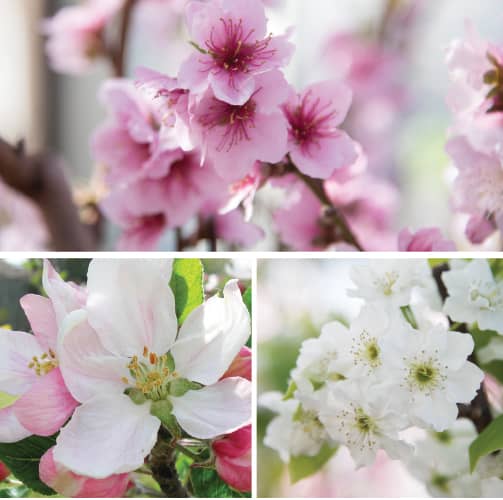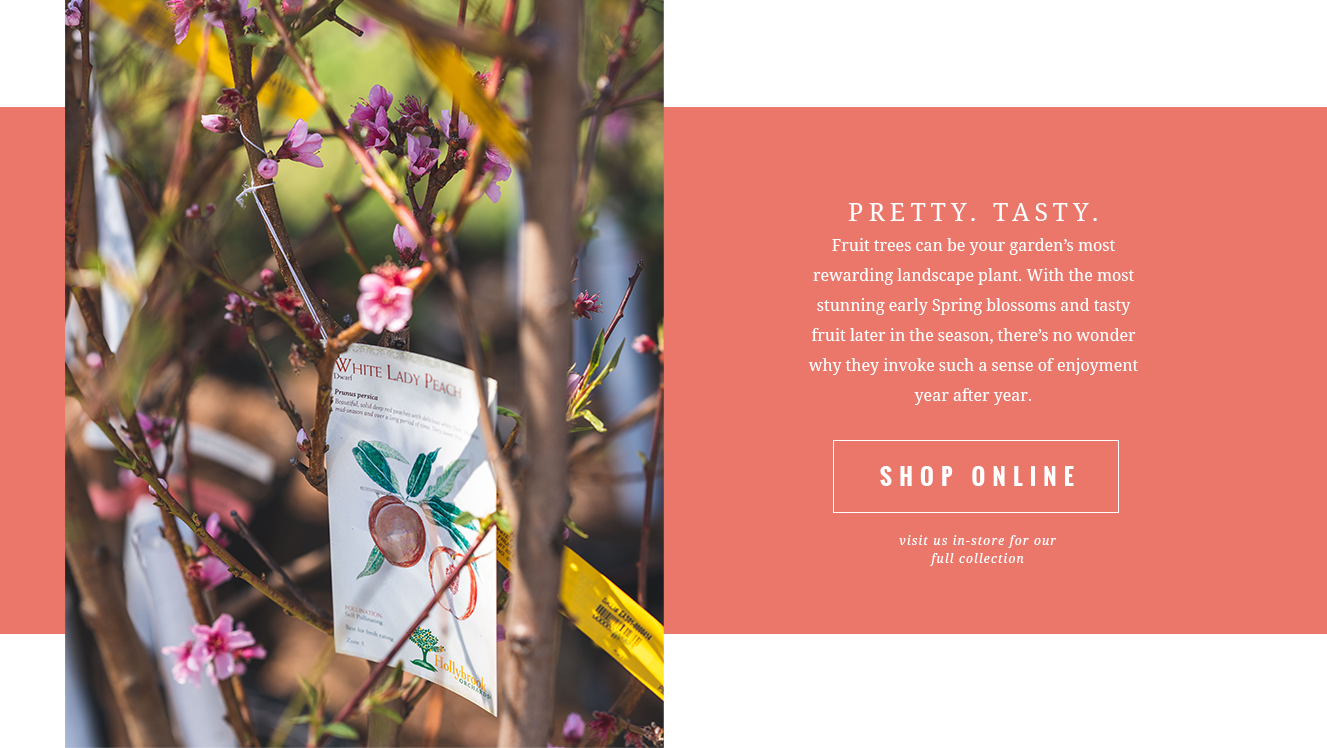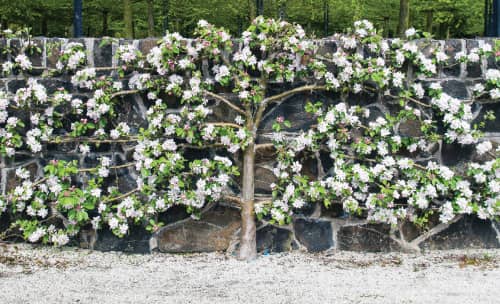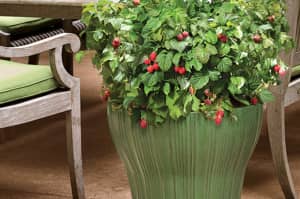After the cold and dreary winter months, we take great delight and joy in watching the color of Spring arrive almost overnight. Seeing the flowers open on a fruit tree are some of the most beautiful indicators of a new season and are both an aesthetically pleasing and functional addition to the landscape. We source fruit trees from all over the country and select only those with the highest quality for the best performance in the New England climate. From apples and pears to apricots and persimmon, adding a fruit tree can add years of enjoyment to your outdoor space. Our buyers stay on top of industry trends and bring in new and unique varieties that you won’t find anywhere else.
 Fruit trees can be your garden’s most rewarding landscape plant. With the most stunning early Spring blossoms and tasty fruit later in the season, there’s no wonder why they invoke such a sense of enjoyment year after year. Note: All fruit trees require full-sun (at least 6 hours per day) and well-draining soil.
Fruit trees can be your garden’s most rewarding landscape plant. With the most stunning early Spring blossoms and tasty fruit later in the season, there’s no wonder why they invoke such a sense of enjoyment year after year. Note: All fruit trees require full-sun (at least 6 hours per day) and well-draining soil.
So what about pollinating? Pollination occurs when pollen is moved within flowers or carried from flower to flower by pollinating animals such as birds, bees, bats, butterflies, moths, beetles, or other animals, or by the wind. Many people shy away from planting fruit trees because of the rules of pollination. Let us help demystify the process!
Fruit results from the pollination of blossoms. Some trees can set an abundant crop with their own pollen, so they are called self-pollinating. Other trees need pollen from another variety. This cross-pollination is usually done by bees. Some neighborhoods have enough fruit trees to assure plenty of cross-pollination, but you should plant your own “pollination partners” just to be sure. If a variety is not self-pollinating, two trees of the same variety will not cross-pollinate each other. Generally speaking, most apples, pears, plums and sweet cherries require a pollinator, although there are a few self-pollinating varieties in each of those fruit types. Peaches, nectarines, tart cherries and apricots are almost always self-pollinating.
To make things easy, all of our fruit trees are tagged with detailed guidance on appropriate pollinators for your apples, pears, plums and sweet cherries. The most important thing to remember? Apples can’t pollinate pears, and pears can’t pollinate plums. Pollinators must be from the same fruit type – cats and dogs don’t breed! We carry dwarf to semi-dwarf varieties that will mature to 12-15’ in height. The compact size allows for planting a single tree in a small back yard, or an entire home orchard to beautify your landscape and provide healthy snacks for the whole family! Each produces full-sized fruit that is easy to harvest.
APPLES
With delicate white pink-blush blossoms, red, green or golden apples, fall foliage, and a classic winter tree shape, apple trees are gorgeous all year long. With a few exceptions, most apple varieties require another variety for pollination. Generally, all you need to worry about is the overlapping of bloom times. If both apples are in bloom at about the same time, then the bees can do their job carrying pollen from one to the other. Early bloomers and mid-season bloomers work fine with each other. And late season bloomers also work fine with mid-season bloomers. But don’t count of early season bloomers and late season bloomers to pollinate each other – most years, they will not be in bloom at the same time. And, of course, planting three varieties – early, mid, and late – will cover all of the bases.
pears
Pears fall into two basic types: European and Asian. They can pollinate across these two types, but the fruit itself is quite different. European pears are generally “pear” shaped, while Asian pears are usually round, like an apple. Sometimes Asian pears are referred to as “apple pears” but their taste is very different from an apple. Asian pears are extremely juicy and almost effervescent to the taste.
SWEET & TART CHERRIES
Most sweet cherries require pollination by another sweet cherry to produce fruit. Black Gold, Hartland and Whitegold are self-pollinating – but the yield of each of those will improve if you plant a pollinator. Almost any combination of two sweet cherries will do the trick. All tart varieties are self-pollinating and do not need another cherry to pollinate.
plums
Generally, Japanese plums need to be pollinated by Japanese plums and European plums need European pollinating partners. This is because the Japanese plums bloom very early and are almost always finished well before the European plums start to bloom. So the pollen from one type is simply not available at the right time to pollinate the other type.
peaches, nectarines & APRICOTS
Peaches, nectarines, and apricots are really simple in terms of pollination. They are all self-pollinating. None of them need another variety to pollinate.



 Espalier is the ancient practice of training a tree or shrub to grow in an artistic flat design against a wall or fence. Don’t have a wall? You can plant a free-standing espalier-trellis to create a private garden or hide your neighbor’s unsightly driveway. They’re easy to care for with just a little seasonal pruning, and because they’re flat against a wall, espalier-grown trees are ideal for small space gardens. Sculptural all year long, they are especially lovely in spring when in flower. And if you select a sunny location, the wall will reflect and retain heat helping your tree produce a lot of fruit in a little area. We have espaliered apples, pears, and Asian pears with multiple varieties grafted on a single plant, so each tree is self-pollinating.
Espalier is the ancient practice of training a tree or shrub to grow in an artistic flat design against a wall or fence. Don’t have a wall? You can plant a free-standing espalier-trellis to create a private garden or hide your neighbor’s unsightly driveway. They’re easy to care for with just a little seasonal pruning, and because they’re flat against a wall, espalier-grown trees are ideal for small space gardens. Sculptural all year long, they are especially lovely in spring when in flower. And if you select a sunny location, the wall will reflect and retain heat helping your tree produce a lot of fruit in a little area. We have espaliered apples, pears, and Asian pears with multiple varieties grafted on a single plant, so each tree is self-pollinating. Perfect for small space gardening.
Perfect for small space gardening. One of our favorite edibles, there are so many reasons to plant blueberries. Easy to grow and prolific, you can harvest the first year you plant! Blueberries are really lovely, with delicate white flowers in the spring, gorgeous foliage in the fall, and colorful branches in the winter. Depending on the variety you choose, blueberries can be used many ways in the landscape. Try them as hardy ground cover, a low border, or a tall hedge for privacy.
One of our favorite edibles, there are so many reasons to plant blueberries. Easy to grow and prolific, you can harvest the first year you plant! Blueberries are really lovely, with delicate white flowers in the spring, gorgeous foliage in the fall, and colorful branches in the winter. Depending on the variety you choose, blueberries can be used many ways in the landscape. Try them as hardy ground cover, a low border, or a tall hedge for privacy.